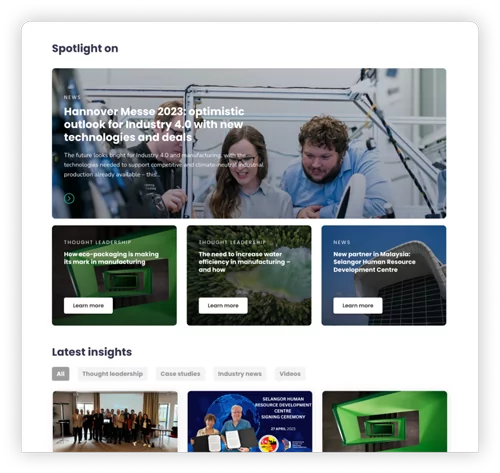Think about the last time you shopped online – where did your item get shipped from? Where was it made? How about the raw materials needed to produce these goods? There’s a high likelihood that your item had to pass through several stages in the supply chain and get transported across different locations before it finally arrived at your doorstep.
Long-distance freight plays a crucial role in ensuring the smooth flow of goods across vast distances, connecting manufacturers with suppliers, distributors, and ultimately, customers. However, the extensive usage of long-distance freight poses significant environmental and social challenges and increased greenhouse gas (GHG) emissions, contributing to climate change and environmental degradation. In fact, the International Energy Agency says that shipping was responsible for around 2% of all energy-related GHG emissions in 2022, contributing to a 5% increase in its carbon footprint.
It is therefore imperative for manufacturers to work with freight service providers and adopt solutions to ensure they hit their environmental, social, and governance (ESG) targets.
The role of mining in driving sustainable logistics practices
The mining sector play a vital role in driving sustainable logistics practices and influencing the supply chain ecosystem. By championing sustainable supply chain management, these manufacturers can set industry standards, inspire positive change among suppliers and partners, and lead by example in adopting green freight technologies and practices.
Moreover, embracing innovation is essential for building a greener and more efficient supply chain. Manufacturers must invest in advanced technologies, collaborate with industry partners, and prioritise sustainability in their operations to drive meaningful progress towards achieving sustainable supply chain goals.
Innovative strategies for optimising long-distance freight
To address the environmental impact of long-distance freight and optimise supply chain sustainability, the mining industry can implement innovative strategies that leverage technology, embrace intermodal transportation, and promote sustainable packaging and handling practices.
Advanced analytics, artificial intelligence (AI), and security technologies can be leveraged for efficient route planning and optimisation in long-distance freight. Not only can real-time data and predictive analytics help manufacturers identify the most efficient transportation routes, saving them up to 20% in transport costs, but they can also reduce GHG emissions.
Along with these smart technologies, intermodal transportation, which involves the use of multiple modes of transportation such as rail, road, and sea, offers a sustainable alternative to traditional freight methods. Plus, it is also more cost effective – potential cost savings of around 10% to 40% can be expected due to factors like lower fuel costs, lower handling charges, and increased efficiency.
Collaborative efforts for sustainable long-distance freight
In addition to implementing innovative strategies, collaborative efforts with eco-friendly carriers, industry partners, and research institutions are essential for driving sustainable long-distance freight practices.
Mining organisations should prioritise partnerships with eco-friendly carriers and service providers that demonstrate a commitment to sustainability. Partnering with carriers that utilise low-emission vehicles, alternative fuels, and energy-efficient transportation technologies, signals that the manufacturers are committed to reducing the environmental impact of their long-distance freight operations. For example, Swedish mining company Boliden is already making progress by collaborating with Volvo to enhance its sustainability efforts.
Furthermore, engaging in industry collaboration is pivotal in driving sustainable supply chain solutions and fostering innovation in long-distance freight. Companies in the mining sector can engage in industry initiatives, partnerships, and forums focused on sustainable supply chain management, sharing best practices, and collectively addressing environmental challenges. By collaborating with industry peers, manufacturers can leverage collective expertise and resources to develop and implement sustainable long-distance freight solutions that benefit the entire supply chain ecosystem.
Measuring and monitoring the sustainability of long-distance freight
How can mining, and the manufacturing sector at large, effectively measure and monitor the sustainability of long-distance freight operations? Here are some ways they can evaluate environmental impact, track progress, and drive continuous improvement in supply chain sustainability.
1. Key performance indicators for evaluating the environmental impact
Manufacturers can establish key performance indicators (KPIs) to evaluate the environmental impact of long-distance freight operations. KPIs such as carbon emissions per ton-mile, fuel efficiency, and waste reduction metrics provide valuable insights into the sustainability of freight transportation.
2. Implementing tracking and reporting systems for transparency
Implementing tracking and reporting systems for transparency and accountability is essential for measuring the sustainability of long-distance freight. Manufacturers can leverage digital platforms, supply chain management software, and IoT-enabled devices to track and report on environmental performance, emissions data, and compliance with sustainability standards. This helps manufacturers demonstrate their commitment to sustainable supply chain practices and build trust with customers, partners, and regulatory authorities.
3. Continuous improvement and adaptation of sustainable practices
Manufacturers should regularly review and refine their sustainable supply chain strategies, incorporating feedback, insights, and lessons learned from monitoring and measurement activities. Having a culture of continuous improvement means manufacturers can proactively address environmental challenges, stay responsive to evolving market demands, and position themselves as leaders in sustainable supply chain management.
Creating greater sustainability across the value chain
The world today relies heavily on long-distance freight for a variety of reasons, but its environmental impact cannot be ignored. Manufacturers seeking to navigate the impact of long-distance freight must understand the environmental and social challenges posed by extensive freight usage and embrace innovative strategies, collaborative efforts, and robust measurement practices to drive meaningful change and achieve sustainable supply chain operations.
Prioritising supply chain sustainability in long-distance freight is not only a responsibility but also an opportunity for manufacturers to minimise environmental impact, enhance brand reputation, and create long-term value for their businesses. By prioritising sustainability, manufacturers can contribute to global efforts to combat climate change, reduce carbon emissions, and promote a healthier and more sustainable future.
To gain a better understanding of current sustainability efforts and where they are in their ESG journey, manufacturers need a guiding compass and a way to assess their progress. This is possible with the help of sustainability maturity assessments and frameworks like the Consumer Sustainability Industry Readiness Index (COSIRI).
With COSIRI manufacturers can gain a clearer understanding and deeper, neutral insights into what needs to be done to accelerate their sustainability transformation. Find out how COSIRI can empower you to attain greener outcomes and transform your supply chain.







